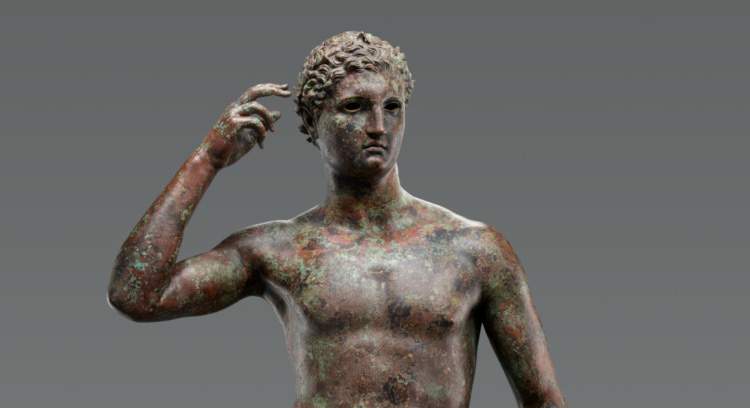Lysippus athlete, the Getty: it was never part of Italian heritage and we don't have to return it
As was widely expected, the Getty Museum does not intend to back down on theLysippus Athlete affair, and its intentions to keep the fourth-century B.C.E. statue remain unaltered even after the Italian justice system gave its final opinion with the verdict of the Court of Cassation, which rejected the U.S. museum’s appeal against theseizure of the work ordered in June by the Pesaro gip.
“We will continue to defend our rights to the statue,” said Lisa Lapin, vice president of communications at the J. Paul Getty Trust. “The law and the facts in this case do not guarantee the Italian government the return of a statue that has been on public display in Los Angeles for nearly half a century. The statue is of ancient Greek origin, was found in international waters in 1964, and purchased by the Getty Museum in 1977, several years after Italy’s highest court, the Corte di Cassazione, concluded in 1968 that there was no evidence that the statue belonged to Italy. Now the court has offered no written explanation to justify its decision, which is contrary to its finding fifty years ago that there was no evidence that the work belonged to Italy.”
“Moreover,” Lapin adds, “the statue was never part of the Italian cultural heritage. An accidental discovery made by Italian citizens does not make the statue an Italian object. Found outside the territory of any modern state, and submerged in the sea for two millennia, the bronze has only a vague and incidental connection to Italy. We believe that any seizure order is contrary to American and international law. Our priority is to continue our productive and long-standing collaborations with our many Italian colleagues and the Ministry of Cultural Heritage. It is regrettable that this affair has distracted us from this important work.”
The Getty also misses no opportunity to emphasize how it has continued to collaborate with Italy for decades, protecting, conserving and researching Italian heritage. “The Getty Foundation,” Lapin lists, “has supported 137 projects on Italian art totaling more than $20 million, awarded $500,000 in university grants to Italian scholars, and hosted 130 Italian scholars, researchers and interns supported by grants totaling more than 1.3 million. Since 1984, the Getty Museum has lent more than 130 paintings, sculptures, drawings, photographs and other works to more than 50 different institutions in Italy. Similarly, the Getty Research Institute (GRI) has lent 70 paintings, drawings, manuscripts and rare books for exhibitions in Italy since 1991. The Getty has presented more than 12 exhibitions in collaboration with Italian institutions, some of them born out of agreements between the Getty and the Italian Minister of Cultural Heritage, the Sicilian Department of Culture and Sicilian Identity, the National Archaeological Museum in Naples, the Capitoline Museums in Rome, and the Museum of Aidone. As part of these collaborations, the Getty was responsible for the conservation of five very significant ancient works and a collection of thirty-seven votive objects, all belonging to Italian museums.”
Again, Lapin concluded, the Getty “places great importance on the strong and fruitful collaboration with the Italian Ministry of Cultural Heritage and with colleagues in Italian museums.”
Finally, in a separate note, the Los Angeles museum wanted to reiterate its position: According to the Getty, the Lysippus Athlete is not Italian, it was not found in Italian waters, and Italian law cannot be applied to the bronze unless Italy can prove that it was found in Italian waters (U.S. law in fact requires that a state claiming cultural property stored in the United States be able to prove that the object was found on its home soil). Moreover, although Italian law applies penalties against those who commit the crime of illegally exporting cultural property, the Getty had nothing to do with any illegal export, and the United States has no laws regarding the return of illegally exported property.
The Getty then justifies its position on additional legal grounds: the 1968 Supreme Court ruling assigning the work to the U.S. museum, the fact that international laws do not impose an obligation to return it (moreover, the Getty points out, the statue left Italy before the 1970 UNESCO Convention existed, and long before Italy and the U.S. ratified it: in any case, the Convention does not obligate the return of objects unless they were stolen from a museum collection), the Italy-US agreement covering the return of objects but only under certain circumstances (i.e., archaeological material of Italian origin, but not Greek objects that have passed through Italy in recent times). Lastly, the Getty objects to the Pesaro judge’s reasoning for deeming the object Italian because it equates the vessel, flying the Italian flag, that found the Lysippus Athlete with national territory: such a justification, in addition to being contrary to the Third United Nations Convention on the Law of the Sea, adopted in 1982, “would produce the absurd case that if the bronze had been found by an Australian fishing vessel, it would have become Australian cultural property.”
 |
| Lysippus athlete, the Getty: it was never part of Italian heritage and we don't have to return it |
Warning: the translation into English of the original Italian article was created using automatic tools. We undertake to review all articles, but we do not guarantee the total absence of inaccuracies in the translation due to the program. You can find the original by clicking on the ITA button. If you find any mistake,please contact us.




























